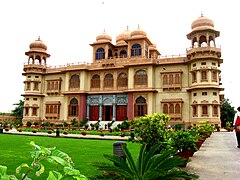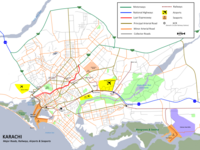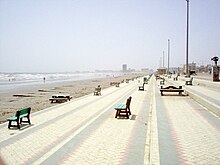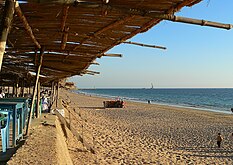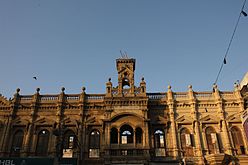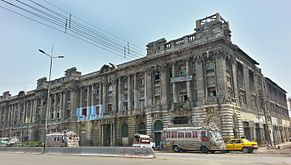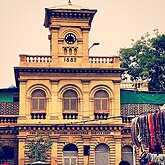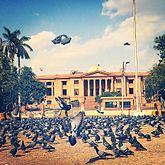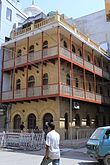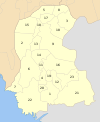Karachi
Karachi
کراچی | |
|---|---|
|
Anti-clockwise from top: Karachi Skyline, Nagan Chowrangi flyover, Muhammad Ali Jinnah's Tomb, Karachi Port Trust, Saint Patrick's Cathedral, Karachi | |
| Nickname(s): | |
| Country | Pakistan |
| Province | Sindh |
| Metropolitan Corporation | 2011 |
| City Council | City Complex, Gulshan-e-Iqbal Town |
| Districts[5] | |
| Government | |
| • Type | Metropolitan City |
| • Mayor of Karachi | Waseem Akhtar |
| • Deputy Mayor of Karachi | Dr. Arshad A. Vohra |
| Area | |
| • Total | 3,527 km2 (1,362 sq mi) |
| Elevation | 8 m (26 ft) |
| Population (2016) | |
| • Total | 24,300,000[8][9] |
| • Rank | 7th (World)[10][10] |
| Demonym | Karachiite |
| Time zone | UTC+05:00 (PKT) |
| Postal codes | 74XXX – 75XXX |
| Dialling code | +9221-XXXX XXXX |
| Website | www |
Karachi (Urdu: کراچی / ALA-LC: [Karācī] Error: {{Transliteration}}: unrecognized language / script code: urdu (help), IPA: [kəˈrɑːˌtʃi] ⓘ) is the largest and most populous city in Pakistan[11] and 7th largest and most populous urban city in the world.[10] It is the capital of Sindh province of Pakistan. It is the main seaport and financial center of Pakistan.[12]. Karachi served as the capital of Pakistan until 1958.[13] Situated on the shores of the Arabian Sea, Karachi is the site of Pakistan's two largest seaports, the Port of Karachi and Port Bin Qasim, as well as Pakistan's busiest airport, Karachi is Pakistan's major industrial and transit hub. Ranked as a beta world city,[14][15] the city is Pakistan's premier financial centre.[16] As the most linguistic, ethnically, and religious diverse city in Pakistan,[17] Karachi exerts strong cultural influence over the rest of Pakistan. Known as the "City of Lights" in the 1960's and 1970's for its vibrant nightlife,[18] Karachi was beset by sharp ethnic and political conflict in the 1980's with the arrival of weaponry from the War in Afghanistan.[19]
Karachi is the second-largest city in the Muslim world.[20] With an estimated population of over 23.5 million people in its greater metropolitan region,[9] it is the world's 7th most populous urban agglomeration,[10][21] and also one of the world's fastest growing cities.[22] Covering area of approximately 3,527 km2 (1,362 sq mi),[23][24] Karachi's expansive metro region has a population density estimated at more than 6,000 people per square kilometre (15,500 per square mile).[25]
Though the Karachi region has been inhabited for millennia,[26] the city traces its roots to a small mixed Sindhi and Balochi fishing village named Kolachi.[27] Karachi was formally established as a fortified trading settlement in 1729.[28] The settlement drastically increased in importance with the arrival of British colonialists who embarked on a major works at the city's port, and established connections to the British India's extensive railway system.[27] By the time of the Partition of British India, the city was the largest in Sindh with an estimated population of 400,000.[17] Immediately following independence, the city's population increased dramatically with the arrival of hundreds of thousands of Muslim refugees from India.[29] Following independence, the city experience rapid economic growth, attracting migrants from throughout Pakistan.[30]
Karachi generates 35% of Pakistan's tax revenue,[31] and has an economy estimated to be worth $78 billion as of 2009.[32] The city also serves a hub of higher education in South Asia and the Muslim world.[33]
History
Founding and early history
The Late Palaeolithic and Mesolithic sites found by the Karachi University team on the Mulri Hills, in front of Karachi University Campus, constitute one of the most important archaeological discoveries made in Sindh during the last 50 years. The last hunter-gatherers, who left abundant traces of their passage, repeatedly inhabited the Hills. Some 20 different locations of flint tools were discovered during the surface surveys.
Karachi was known to the ancient Greeks by many names: Krokola, the place where Alexander the Great camped to prepare a fleet for Babylonia after his campaign in the Indus Valley; Morontobara (probably Manora island near Karachi harbour), from whence Alexander's admiral Nearchus set sail; and Barbarikon, a port of the Bactrian kingdom. It was later known to the Arabs as Debal from where Muhammad bin Qasim led his conquering force into South Asia in AD 712.[34]
Karachi was reputedly founded as "Kolachi" by Baloch tribes from Balochistan and Makran, who established a small fishing community in the area.[35] Descendants of the original community still live in the area on the small island of Abdullah Goth, which is located near the Karachi Port. The original name "Kolachi" survives in the name of a well-known Karachi locality named Mai Kolachi in Balochi.
Mughal Empire
Mirza Ghazi Beg, the Mughal administrator of Sindh, is among the first historical figures credited for the development of coastal Sindh (consisting of regions such as the Makran coast and the Indus delta),[where?] including the cities of Thatta, Bhambore and Karachi. During his rule the city was well fortified against Portuguese colonial incursions in Sindh. Debal and the Manora Island and was visited by Ottoman admiral Seydi Ali Reis and mentioned in his book Mir'ât ül Memâlik in 1554. The ancient names of Karachi included: Krokola, Barbarikon, Nawa Nar, Rambagh, Kurruck, Auranga Bandar, Minnagara, Kolachi, Morontobara, Kolachi-jo-Goth, Banbhore, Debal, Barbarice and Kurrachee.[36][37]
The village that later grew out of this settlement was known as Kolachi-jo-Goth (Village of Kolachi in Sindhi). By the late 1720s, the village was trading across the Arabian Sea with Muscat and the Persian Gulf region. The local Sindhi populace built a small fort, that was constructed for the protection of the city, armed with cannons imported by Sindhi sailors from Muscat, Oman. The fort had two main gateways: one facing the sea, known as Kharra Darwaaza (Brackish Gate) (Kharadar) and the other facing the Lyari River known as the Meet'ha Darwaaza (Sweet Gate) (Mithadar), which correspond to the modern areas of Kharadar and Mithadar.
The name Karachi was used for the first time in a Dutch document of 1742, when a merchant ship de Ridderkerk shipwrecked nearby its coast.[38][39] The city continued to be ruled by the Talpur Amir's of Sindh until it was occupied by Bombay Army under the command of John Keane on 2 February 1839.[40]
British Raj

After some exploratory missions to the area, the British East India Company captured the town when HMS Wellesley anchored off Manora island on 1 February 1839. Two days later, the little fort surrendered.[41] The town was later annexed to British East India Company held territories in India when parts of Sindh were captured by Major General Charles James Napier after their victory in the Battle of Miani on 17 February 1843.
On his departure in 1847, Napier is said to have remarked, "Would that I could come again to see you in your grandeur!" Karachi was made the capital of Sindh after British victory in 1843. On Napier's departure, it was added along with the rest of Sindh to the Bombay Presidency, a move that caused resentment among the native Sindhis. The British realised the importance of the city as a military cantonment and as a port for exporting the produce of the Indus River basin, and developed its harbour for shipping. The foundations of a city municipal government were laid down and infrastructure development was undertaken. New businesses opened up and the population of the town began rising.
The arrival of the troops of the Company Bahadur in 1843 spawned the foundation of the new section, the military cantonment. The cantonment formed the basis of the 'white' town, where the local population had limited access. This town was modelled after English industrial parent-cities, where work and residential spaces were separated, as were residential from recreational places. The 'native' town in the northwest, was enlarged to accommodate the burgeoning mercantile population. When the Indian Rebellion of 1857 broke out in South Asia, the 21st Native Infantry, then stationed in Karachi, declared allegiance to the rebels and joined their numbers on 10 September 1857. Nevertheless, the British were able to quickly reassert control over Karachi and defeat the uprising. Officer William 'Waf' Frost was considered to be instrumental in quelling the rebellion and was rewarded for his valor with an Order of the British Empire. This was awarded to him on 23 April 1858. However, he remains unpopular in areas of Karachi to this day.

In 1864, the first telegraphic message was sent from South Asia to England, when a direct telegraph connection had been laid between Karachi and London.[42] In 1878, the city was connected to the rest of British India by rail. Public building projects, such as Frere Hall (1865) and the Empress Market (1890), were undertaken. In 1876, Muhammad Ali Jinnah, the founder of Pakistan, was born in the city according to some accounts, which by now had become a bustling city with mosques, temples, courthouses, paved streets and a harbour. By 1899, Karachi had become the largest wheat exporting port in the East.[43] Before 1880 the majority of the population of Karachi consisted of the indigenous Sindhis and Balochis (who also spoke Sindhi as a second language). These developments in Karachi resulted in an influx of economic migrants: Parsis, Hindus, Christians, Jews, Marathis, Goan Christian, Chinese, British, Arabs and Gujaratis. The population of the city was about 105,000 inhabitants by the end of the 19th century, with a mix of nationalities.[44]
Post-independence
By the time of Pakistan's independence in 1947, Karachi had become a bustling metropolis with slightly under half a million people, and classical and colonial European styled buildings lining the city's thoroughfares. In 1947, Karachi was chosen as the capital of Pakistan. Despite communal violence across India and Pakistan, Karachi remained peaceful[2] but it became the focus for the resettlement of Muslim Muhajirs fleeing from the anti-Muslim pogroms in India, which expanded the city's population and transformed its demographics and economy.

Between 1958 and 1970, Karachi was neither the capital of Pakistan nor the capital of Sindh due to the One Unit program being enacted.[2] In 1958, the capital of Pakistan was moved from Karachi to Rawalpindi. The foreign embassies in Karachi moved to the newly developed capital Islamabad, near Rawalpindi. There are Consulates and honorary consulates as diplomatic missions in Karachi.[45]
During the 1960s, Karachi was seen as an economic role model around the world. Many countries sought to emulate Pakistan's economic planning strategy and one of them, South Korea, copied the city's second "Five-Year Plan" and the World Financial Center in Seoul is designed and modeled after Karachi.[46][47] Karachi had both a municipal corporation and a Karachi Divisional Council in the 1960s, which developed schools, colleges, roads, municipal gardens, and parks. The Karachi Divisional Council had working committees for education, roads, and residential societies development and planning.[48] Shifting of capital marked the start of a long period of decline in the city, especially causing the reduction in large-scale industry by 37.9%.[49]
The 1970s saw major labour struggles in Karachi's industrial estates. The 1980s and 1990s saw an influx of thousands of Afghan refugees from the Soviet war in Afghanistan into Karachi; they were followed in smaller numbers by refugees escaping from Iran.[50] Karachi ethnic groups included:Sindhis, Punjabis, Kashmiris, Seraikis, Pakhtuns, Balochis, Memons and Muhajirs , Bohras, Ismailis, etc. After the 1970s Karachi has become home to about five to seven million Pashtuns, which is more than Khyber Pakhtunkhwa.[51][52] In the late 1980s and early 1990s, ethnic and political violence broke out across the city when Muhajir followers of the Mohajir Qaumi Movement fought with ethnic Sindhis, Pashtuns, Punjabis, and security forces. As a result, the Army was deployed to restore peace in the city.[53]
Today, Karachi is an important financial and industrial centre and handles most of the overseas trade of Pakistan and the world, mainly the Asian countries. It accounts for a significant share of the GDP of Pakistan.[54]
Geography

City geographic coordinates are 24°51′ N 67°02′ E. Most of the land consists of flat or rolling plains, with hills on the western and Manora Island and the Oyster Rocks. The Arabian Sea beach lines the southern coastline of Karachi. Mangroves and creeks of the Indus delta can be found toward the southeast side of the city. Toward the west and the north is Cape Monze, locally known as Ras Muari, an area marked by projecting sea cliffs and rocky sandstone promontories. Some excellent beaches can be found in this area. Khasa Hills and Mulri Hills lie in the northwest and form the border between North Nazimabad Town[55] and Orangi Town. The Manghopir Hills lies northwest of Karachi, between Hub River and Manghopir. The hills in Karachi are the offshoots of the Kirthar Range. The highest point of these hills in Karachi is about 528 m in the extreme north. All these hills are devoid of vegetation and have wide intervening plains, dry river beds and water channels. The rivers in Karachi are Malir River and Lyari River. The Indus River flood plain is near Karachi. The city is located on the Arabian Sea coastline.[56]
Climate

Located on the coast, Karachi has an arid climate with low average precipitation levels (approx. 250 mm (9.8 in) per annum), the bulk of which occurs during the July–August monsoon season. Winters are warm and dry, while the summers are hot and humid; the proximity to the sea maintains humidity levels at a near-constant high and cool sea breezes relieve the heat of the summer months. December through February are dry and pleasant as compared to the warm summers that dominate through the late spring (March) to the pre-monsoon season (June). Karachi is considered to be one of the hottest cities on the planet.[57] The city's weather can be compared to that of US state of Florida in level of heat, humidity and mosquito population.[58]
The city's highest monthly rainfall, 429.3 mm (16.90 in), occurred in July 1967.[59] The city's highest rainfall in 24 hours occurred on 7 August 1953, when about 278.1 millimetres (10.95 in) of rain lashed the city, resulting in major flooding.[60] Karachi's highest recorded temperature is 48 °C (118 °F) which was recorded on 9 May 1938,[61] and the lowest is 0 °C (32 °F) recorded on 21 January 1934.[59] Template:Karachi weatherbox
Economy

Karachi is the financial and commercial capital of the Islamic Republic of Pakistan.[62] In line with its status as a major port and the country's largest metropolis, it accounts for a lion's share of Pakistan's revenue. According to the Federal Board of Revenue's 2006–2007 year book, tax and customs units in Karachi were responsible for 46.75% of direct taxes, 33.65% of federal excise tax, and 23.38% of domestic sales tax.[63] Karachi accounts for 75.14% of customs duty and 79% of sales tax on imports.[63] Therefore, Karachi collects 53.38% of the total collections of the Federal Board of Revenue, out of which 53.33% are customs duty and sales tax on imports.[63] (Note: Revenue collected from Karachi includes revenue from some other areas since the Large Tax Unit (LTU) Karachi and Regional Tax Offices (RTOs) Karachi, Hyderabad, Sukkur & Quetta cover the entire province of Sindh and Balochistan).[63] Karachi's indigenous contribution to national revenue is around 25%.[54]

Karachi's contribution to Pakistan's manufacturing sector amounts to approximately 30 percent.[64] A substantial part of Sindh's gross domestic product (GDP) is attributed to Karachi[65][66] (the GDP of Sindh as a percentage of Pakistan's total GDP has traditionally hovered around 28%–30%; for more information, see economy of Sindh).[65][66][67][68] Karachi's GDP is around 20% of the total GDP of Pakistan.[54][69] A PricewaterhouseCoopers study released in 2009, which surveyed the 2008 GDP of the top cities in the world, calculated Karachi's GDP (PPP) to be $78 billion[32] (projected to be $193 billion in 2025 at a growth rate of 5.5%).[32] It confirmed Karachi's status as Pakistan's largest economy, well ahead of the next two biggest cities Lahore and Faisalabad, which had a reported GDP (PPP) in 2008 of $40 billion and $14 billion, respectively.[32] Karachi's high GDP is based on its industrial base, with a high dependency on the financial sector. Textiles, cement, steel, heavy machinery, chemicals, food, banking and insurance are the major segments contributing to Karachi's GDP.[70]
Karachi is the nerve center of Pakistan's economy. The economic stagnation caused by political anarchy, ethnic strife and resultant military operation during the late 1980s and 1990s led to an exit of industry from Karachi. Most of Pakistan's public and private banks are headquartered on Karachi's I. I. Chundrigar Road which is known as "Pakistan's Wall Street";[2] according to a 2001 report, nearly 60% of the cashflow of the Pakistani economy takes place on I. I. Chundrigar Road. It was in 1963 when Habib Bank Plaza was built on this road which remained Pakistan's tallest building until 2000s when it was outgrown by two other buildings in Karachi.[2] Most major foreign multinational corporations operating in Pakistan have their headquarters in Karachi. The Karachi Stock Exchange is the largest stock exchange in Pakistan, and is considered by many economists to be one of the prime reasons for Pakistan's 8% GDP growth across 2005.[71] A recent report by Credit Suisse on Pakistan's stock market is a testimonial to its strong fundamentals, estimating Pakistan's relative return on equities at 26.7 percent, compared to Asia's 11 percent.[72]

Karachi has seen an expansion of information and communications technology and electronic media and has become the software outsourcing hub of Pakistan. Call centres for foreign companies have been targeted as a significant area of growth, with the government making efforts to reduce taxes by as much as 10% to gain foreign investments in the IT sector.[73][74] Many of Pakistan's independent television and radio stations are based in Karachi, including world-popular Business Plus, AAJ News, Geo TV, KTN,[75] Sindh TV,[76] CNBC Pakistan, TV ONE, ARY Digital, Indus Television Network, Samaa TV and Dawn News, as well as several local stations.
Karachi has large industrial zones such as Karachi Export Processing Zone, SITE, Korangi, Northern Bypass Industrial Zone, Bin Qasim and North Karachi, located on the fringes of the main city.[77] Its primary areas of industry are textiles, pharmaceuticals, steel, and automobiles. In addition, Karachi has a cottage industry and there is a Free Zone with an annual growth rate of nearly 6.5%. The Karachi Expo Centre hosts regional and international exhibitions.[78]
| Name of estate | Location | Established | Area in acres |
|---|---|---|---|
| SITE Karachi | SITE Town | 1947 | 4700[79] |
| Korangi Industrial Area | Korangi Town | 1960 | 8500[80] |
| Landhi Industrial Area | Landhi Town | 1949 | 11000[81] |
| North Karachi Industrial Area | New Karachi Town | 1974 | 725[82] |
| Federal B Industrial Area | Gulberg Town | 1987 | [83] |
| Korangi Creek Industrial Park | Korangi Creek Cantonment | 250[84] | |
| Bin Qasim Industrial Zone | Bin Qasim Town | 1970 | 25000[85] |
| Karachi Export Processing Zone | Landhi Town | 1980[86] | 315[87] |
| Pakistan Textile City | Bin Qasim Town | 2004 | 1250[88] |
| West Wharf Industrial Area | Keamari Town | 430 | |
| SITE Super Highway Phase-I | Super Highway | 1983 | 300[89] |
| SITE Super Highway Phase-II | Super Highway | 1992 | 1000[89] |
There are development projects proposed, approved and under construction in Karachi. Among projects of note, Emaar Properties is proposing to invest $43bn (£22.8bn) in Karachi to develop Bundal Island, which is a 12,000 acres (49 km2) island just off the coast of Karachi.[90] The Karachi Port Trust is planning a Rs. 20 billion, 1,947 feet (593 m) high Port Tower Complex on the Clifton shoreline.[91][92] It will comprise a hotel, a shopping center, an exhibition center and a revolving restaurant with a viewing gallery offering a panoramic view of the coastline and the city.[93]
Civic administration

Lyari is the oldest settlement while Saddar Town is one of the oldest parts of the city but not as old as Lyari.[94][95] The first form of government was a conservancy board established in 1846 to control the spread of cholera in the city.[96] The board became a municipal commission in 1852, and a municipal committee the following year.[96] The City of Karachi Municipal Act of 1933 transformed the city administration into a municipal corporation with a mayor, a deputy mayor and 57 councillors.[96] During the 1900s, Karachi saw its major beautification project under the mayoral administration of Harchandrai Vishandas. New roads, parks, residential and recreational areas were developed as part of this project. In 1940, Karachi Municipal Corporation banned the South African Europeans from entering the city due to South Africa's anti-Indian legislation based on their racist policies.[2] In 1948, the Federal Capital Territory of Pakistan was created, comprising approximately 2,103 km2 (812 sq mi) of Karachi and surrounding areas, but this was merged into the province of West Pakistan in 1961.[97] However, the municipal corporation remained in existence and in 1976 became a metropolitan corporation, followed by the creation of zonal municipal committees, which lasted until 1994.[96] Two years later the metropolitan area was divided into five districts, each with a municipal corporation.[96]

In 2001, five districts of Karachi were merged to form the city district of Karachi. It was structured as a three-tier federation, with the two lower tiers composed of 18 towns and 178 union councils,[98] with each tier focused on elected councils with some common members to provide "vertical linkage" within the federation.[99] Each union council comprised thirteen members elected from specified electorates: four men and two women elected directly by the general population; two men and two women elected by peasants and workers; one member for minority communities; two members are elected jointly as the union mayor (nazim) and deputy union mayor (naib nazim).[100] Each town council comprised the deputy union mayors in the town as well as elected representatives for women, peasants and workers, and minorities.[101] The district council comprised all of the union mayors in the district as well as elected representatives for women, peasants and workers, and minorities.[102] Each council included up to three council secretaries and a number of other civil servants. Naimatullah Khan was the first Nazim of Karachi and Shafiq-Ur-Rehman Paracha was the first district co-ordination officer (DCO) of Karachi, Paracha even served as the last Commissioner of Karachi. Syed Mustafa Kamal was elected City Nazim of Karachi to succeed Naimatullah Khan in 2005 elections, and Nasreen Jalil was elected as the City Naib Nazim.
Again in 2011, City District Government of Karachi has been de-merged into its five original constituent districts namely Karachi East, Karachi West, Karachi Central, Karachi South and Malir. In November 2013, another district, "Korangi" carved out from District East after which the number of districts in Karachi rose to Six. So there are now six administrative districts in Karachi.[103][104][105][106][107] City administrator is Muhammad Hussain Syed[108] and Municipal Commissioner of Karachi is Matanat Ali Khan.[109] The position of Commissioner of Karachi was created and Shoaib Ahmad Siddiqui was appointed as the Commissioner of Karachi.[110] There are six military cantonments, which are administered by the military.

|
|
Demographics
Karachi's inhabitants, locally known as Karachiites, are composed of ethno-linguistic groups from all parts of Pakistan, as well as migrants from other parts of South Asia, making the city a most diverse melting pot of the country. Karachi was always considered a migrant city, Hindus and Muslims alike migrated from different parts of India to Karachi during British Raj. Oldest settlement of the city was Lyari[2] where first inhabitants settled who were mostly Sindhi fishermen and Baloch nomads. It is the densest, most impoverished and violence-ridden part of the city which was ignored for infrastructure development by British and post-partition provincial governments at the cost of more development for Urdu-speaking areas of the city.[95] At the end of the 19th century, the population of the city was about 105,000, with a gradual increase over the next few decades, reaching more than 400,000 on the eve of independence. Estimates of the population range from 15 to 18 million,[111][112] of which an estimated 90% are migrants from different backgrounds. The city's population is estimated to be growing at about 5% per year (mainly as a result of internal rural-urban migration), including an estimated 45,000 migrant workers coming to the city every month from different parts of Pakistan.[113]

Karachi has a multi-religious community which includes followers of various sects and sub-sects of Islam, Catholic and Protestant Christianity, Hinduism and Zoroastrianism living in their own clustered pockets of population in the city. Before the end of British colonial rule and the subsequent independence of Pakistan in 1947, the population of the city was 50% Hindu, 40% Muslim and the remaining was Christian (both British and local), Zoroastrian, Buddhist and Jewish.[2] Hindu community was around 250,000 residents according to 2013 data.[114]
| Rank | Language | 1998 census[115] | Speakers | 1981 census[116] | Speakers |
|---|---|---|---|---|---|
| 1 | Urdu | 48.52% | 4,497,747 | 54.34% | 2,830,098 |
| 2 | Standard Punjabi | 13.94% | 1,292,335 | 13.64% | 710,389 |
| 3 | Pashto | 11.42% | 1,058,650 | 08.71% | 453,628 |
| 4 | Sindhi | 07.22% | 669,340 | 06.29% | 327,591 |
| 5 | Balochi | 04.34% | 402,386 | 04.39% | 228,636 |
| 6 | Saraiki (Punjabi) |
02.11% | 195,681 | 00.35% | 18,228 |
| 7 | Others | 12.44% | 1,153,126 | 12.27% | 639,560 |
| All | 100% | 9,269,265 | 100% | 5,208,132 |
| Population growth | |||
|---|---|---|---|
| Year | Pop. | %± | |
| 1729 | 250 | — | |
| 1838 | 14,000 | 5,500.0% | |
| 1842 | 15,000 | 7.1% | |
| 1850 | 16,773 | 11.8% | |
| 1856 | 22,227 | 32.5% | |
| 1861 | 56,859 | 155.8% | |
| 1881 | 73,560 | 29.4% | |
| 1891 | 105,199 | 43.0% | |
| 1901 | 136,297 | 29.6% | |
| 1911 | 186,771 | 37.0% | |
| 1921 | 244,162 | 30.7% | |
| 1931 | 300,779 | 23.2% | |
| 1941 | 435,887 | 44.9% | |
| 1951 | 1,137,667 | 161.0% | |
| 1961 | 2,044,044 | 79.7% | |
| 1972 | 3,606,744 | 76.5% | |
| 1981 | 5,437,984 | 50.8% | |
| 1986 | 7,443,663 | 36.9% | |
| 1998 | 9,802,134 | 31.7% | |
| Source:[117][118][111]
†Huge population rise between 1941 and 1951 due to large scale migration after independence in 1947 | |||

The city was, and still is home to a large community of Gujarati Muslims who were one of the earliest settlers in the city, and still form the majority in Saddar Town.[citation needed] Important Gujarati Muslim communities in the city include the Memon, Chhipa, Ghanchi, Khoja, Bohra and Tai.[citation needed]
Other early settlers included the Marwari Muslims, Parsis, Marathi Muslims and Konkani Muslims from Maharashtra (settled in Kokan Town), Goan Catholics and Anglo-Indians.[citation needed] Most non-Muslims left the city to India in the 1950s, after independence, but there are still small communities of Parsis, Goan Catholics and Anglo-Indians in the city.[citation needed]
The independence of Pakistan in 1947 saw the influx of Muslim Muhajirs from India fleeing from anti-Muslim pograms. The majority of the Urdu-speaking and other non-Punjabi Muslim refugees that fled from various North Indian cities and towns settled in Karachi, which is why the culture of the city is a blend of South Asia. Most of the property vacated by non-Muslims, who left Karachi due to the new settlements made by these refugees, were granted to Muslim refugees through claims on behalf of the property they claimed leaving behind in India.[2][119] The demographics of the city changed from 50% Hindu and 40% Muslim to 90% Muslim, 70% of which was made up of new migrants from India.[2] Today, the descendants of these Muslim refugees are known as Muhajirs and form a large, powerful group in Karachi. These Muhajirs include Urdu-speaking, Gujarati, Marathi, Konkani, Rajasthani, and Malabari Muslims from India. Due to socio-economic pressures on Muslims in India, many Muslim families from all over India continued migrating to Pakistan throughout the 1950s and even early 1960s.[120] From 1960s and onwards, Punjabis from Punjab and Pakhtuns from NWFP (now Khyber Pakhtunkhwa) continued migrating to Karachi due to its economical viability.[2] After the Indo-Pakistani War of 1971, thousands of Biharis and Bengalis from Bangladesh arrived in the city, and today Karachi is home to 1 to 2 million ethnic Bengalis from Bangladesh (see Bangladeshis in Pakistan),[121][122] many of whom migrated in the 1980s and 1990s. They were followed by Rohingya Muslim refugees from western Burma (for more information, see Burmese people in Pakistan),.[123][124] These small ethno-linguistic groups are being assimilated in the Urdu-speaking community.[119]
Karachi is host to many Western expatriates in Pakistan including Asian refugees from Uganda. One under-privileged sub-ethnic group is the Siddis (Africans – Sheedi) who are now naturalised Sindhi speakers. They are descended from African slaves.[125] Many other refugees from Iran (who stayed till the late 1980s) and the Central Asian countries constituting the former Soviet Union have settled in the city as political or economic migrants. A large numbers of Arabs, Filipinos and an economic elite of Sinhalese from Sri Lanka.[126] Expatriates from China have a history going back to the 1940s; today, many of the Chinese are second-generation children of immigrants who came to the city and worked as dentists, chefs and shoemakers.[126][127]
During World War II, about 3,000 Polish refugees from the Soviet Union were evacuated to Karachi by the British. Some of these Polish families settled permanently in the city.[128][129] There are communities of American[130] and British expatriates. After the independence of Pakistan, a considerable number of Punjabi Muslims from Pakistani Punjab settle in Karachi. Punjabi and Pashtun are two out of three major ethnic groups in Karachi. The Pashtuns, originally from the province of Khyber Pakhtunkhwa, Federally Administered Tribal Areas and northern Balochistan, are settled in Karachi post independence. Additionally several Afghan Pashtun refugees settled in Karachi during the 80's,[51][52] including 50,000 registered Afghan refugees in the city.[131][132][133] There is a sizeable community of Kashmiri Muslims from the Kashmir Valley.[134]
Karachi has the largest number of Urdu speakers compared to any other city in Pakistan.[135] According to the last official census of the city, which was held in 1998, the linguistic distribution of the city was: Urdu: 48.52%; Punjabi: 16.05%; Pashto: 25.01%; <Sindhi: 7.22%; Balochi: 4.34%; others: 12.44%. The others include Dari, Gujarati, Dawoodi Bohra, Memon, Marwari, Brahui, Makrani, Hazara, Khowar, Burushaski, Arabic, Farsi and Bengali.[136]
Tourist attractions

Karachi is a tourist destination for domestic and international tourists. Some tourist attractions near Karachi city are:
Beaches: The beaches of Karachi are the main attraction for tourists. There are many beautiful seasides near city like Seaview, Manora Island, Sandspit Beach, Hawke's Bay Beach,[137] Paradise Point, French Beach, Cape Monze, and Nathiagali Beach.
Museums: The main museum of Karachi is National Museum of Pakistan others are Pakistan Air Force Museum and Pakistan Maritime Museum.
Parks: Some popular parks are Bagh Ibne Qasim, Boat Basin Park, Mazar-e-Quaid, Karachi Zoo, Hill Park, Safari Park, Bagh-e-Jinnah, PAF Museum Park and Maritime Museum Park.
Historic places and buildings: Chowkandi graveyard is the most historic place in Karachi, famous for hundred-year old tombs. Historic buildings in the city were constructed in the British era like Karachi Port Trust, Sindh High Court. Hindu Gymkhana, Shri Varun Dev Mandir, KMC Head Office, Ghulam Husain Khalikdina Hall, Frere Hall, Empress Market, Jehangir Kothari Parade, St Patrick's Church, Mohatta Palace and Karachi Cantonment Railway Station buildings.[138][failed verification]
Lake and National Park: Hub lake is 56 kilometres away in north of Karachi. It is an ideal place to birds watching, picnic, swimming and fishing. The Kirthar National Park is located near this lake. The park is the home of Striped hyenas, Wolves, Ratels, Urials, Indian Gazelles and Sind wild goats.
Art and culture
Karachi is home to some of Pakistan's important cultural institutions. The National Academy of Performing Arts,[139] located in the newly renovated Hindu Gymkhana, offers a two-year diploma course in performing arts that includes classical music and contemporary theatre. The All Pakistan Music Conference, linked to the 45-year-old similar institution in Lahore, has been holding its annual music festival since its inception in 2004.[140] The National Arts Council (Koocha-e-Saqafat) has musical performances and mushaira. The Kara Film Festival annually showcases independent Pakistani and international films and documentaries.[141] Karachi is home to theatre, music and dance performance groups, such as Thespianz Theater, a professional youth-based, non-profit performing arts group, which works on theatre and arts activities in Pakistan.[142][143] Karachi has museums that present exhibitions on a regular basis, including the Mohatta Palace and the National Museum of Pakistan. Karachi Expo Centre hosts regional and international exhibitions.
Architecture
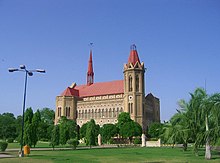
Karachi has a collection of buildings and structures of varied architectural styles. The downtown districts of Saddar and Clifton contain early 20th-century architecture, ranging in style from the neo-classical KPT building to the Sindh High Court Building. Karachi acquired its first neo-Gothic or Indo-Gothic buildings when Frere Hall, Empress Market and St. Patrick's Cathedral were completed. The Mock Tudor architectural style was introduced in the Karachi Gymkhana and the Boat Club. Neo-Renaissance architecture was popular in the 19th century and was the architectural style for St. Joseph's Convent (1870) and the Sind Club (1883).[144] The classical style made a comeback in the late 19th century, as seen in Lady Dufferin Hospital (1898)[145] and the Cantt. Railway Station. While Italianate buildings remained popular, an eclectic blend termed Indo-Saracenic or Anglo-Mughal began to emerge in some locations.[146]
The local mercantile community began acquiring impressive structures. Zaibunnisa Street in the Saddar area (known as Elphinstone Street in British days) is an example where the mercantile groups adopted the Italianate and Indo-Saracenic style to demonstrate their familiarity with Western culture and their own. The Hindu Gymkhana (1925) and Mohatta Palace are examples of Mughal revival buildings.[147] The Sindh Wildlife Conservation Building, located in Saddar, served as a Freemasonic Lodge until it was taken over by the government. There are talks of it being taken away from this custody and being renovated and the Lodge being preserved with its original woodwork and ornate wooden staircase.[148]

Indus Valley School of Art and Architecture is one of the prime examples of Architectural conservation and restoration where an entire Nusserwanjee building from Kharadar area of Karachi has been relocated to Clifton for adaptive reuse in an art school. The procedure involved the careful removal of each piece of timber and stone, stacked temporarily, loaded on the trucks for transportation to the Clifton site, unloaded and re-arranged according to a given layout, stone by stone, piece by piece, and completed within three months.[149]
Architecturally distinctive, even eccentric, buildings have sprung up throughout Karachi. Notable example of contemporary architecture include the Pakistan State Oil Headquarters building. The city has examples of modern Islamic architecture, including the Aga Khan University hospital, Masjid e Tooba, Faran Mosque, Bait-ul Mukarram Mosque, Quaid's Mausoleum, and the Textile Institute of Pakistan. One of the unique cultural elements of Karachi is that the residences, which are two- or three-story townhouses, are built with the front yard protected by a high brick wall. Ibrahim Ismail Chundrigar Road features a range of extremely tall buildings. The most prominent examples include the Habib Bank Plaza, PRC Towers and the MCB Tower which is the tallest skyscraper in Pakistan.[150]
Art galleries
There are many art galleries in Karachi for the exhibition of art especially the visual art.[151]
Sports
When it comes to sports Karachi has a distinction, because some sources cite that it was in 1877 at Karachi in (British) India, where the first attempt was made to form a set of rules of badminton[153] and likely place is said to Frere Hall.
Cricket in Pakistan has a history of even before the creation of the country in 1947. The first ever international cricket match in Karachi was held on 22 November 1935 between Sindh and Australian cricket teams. The match was seen by 5,000 Karachiites.[154]
The National Stadium is the city's only world-class cricket stadium, and is the second largest cricket stadium in Pakistan, after the Gaddafi Stadium in Lahore.[citation needed] The inaugural first-class match at the National Stadium was played between Pakistan and India on 26 February 1955 and since then Pakistani national cricket team has won 20 of the 41 Test matches played at the National Stadium.[155] The first One Day International at the National Stadium was against the West Indies on 21 November 1980, with the match going to the last ball.
The national team has been less successful in such limited-overs matches at the ground, including a five-year stint between 1996 and 2001, when they failed to win any matches. The city has been host to a number of domestic cricket teams including Karachi,[156] Karachi Blues,[157] Karachi Greens,[158] and Karachi Whites.[159] The National Stadium hosted two group matches (Pakistan v. South Africa on 29 February and Pakistan v. England on 3 March), and a quarter-final match (South Africa v. West Indies on 11 March) during the 1996 Cricket World Cup.[160]
The city has hosted seven editions of the National Games of Pakistan, most recently in 2007.[161] Sports like badminton, volleyball, and basketball are popular in schools and colleges. Football is especially popular in Lyari Town, which has a large Afro-Balochi community and has always been a football-mad locality in Karachi. The Peoples Football Stadium is perhaps the largest football stadium in Pakistan with respect to capacity, easily accommodating around 40,000 people.[citation needed]
In 2005, the city hosted the SAFF Championship at this ground, as well as the Geo Super Football League 2007, which attracted capacity crowds during the games. The popularity of golf is increasing, with clubs in Karachi like Dreamworld Resort, Hotel & Golf Club, Arabian Sea Country Club, DA Country & Golf Club. The city has facilities for field hockey (the Hockey Club of Pakistan, UBL Hockey Ground), boxing (KPT Sports Complex), squash (Jahangir Khan Squash Complex), and polo. There are marinas and boating clubs. National Bank of Pakistan Sports Complex is First-class cricket venue and Multi-purpose sports facility in Karachi,
- Professional Karachi teams
| Club | League | Sport | Venue | Established |
|---|---|---|---|---|
| Karachi Kings | Pakistan Super League | Cricket | Dubai International Cricket Stadium | 2015 |
| Karachi Dolphins | National T20 League/National One-day Championship | Cricket | National Stadium | 2004 |
| Karachi Zebras | National T20 League/National One-day Championship | Cricket | National Stadium | 2004 |
| HBL FC | Pakistan Premier League | Football | Peoples Football Stadium | 1975 |
| K-Electric F.C. | Pakistan Premier League | Football | Peoples Football Stadium | 1913 |
| KPT F.C. | Pakistan Premier League | Football | KPT Football Stadium | 1887 |
| NBP F.C. | Pakistan Premier League | Football | KPT Football Stadium | N/A |
| PIA F.C. | Pakistan Premier League | Football | KPT Football Stadium | 1958 |
Education
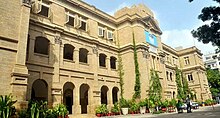
Education in Karachi is divided into five levels: primary (grades one through five); middle (grades six through eight); high (grades nine and ten, leading to the Secondary School Certificate); intermediate (grades eleven and twelve, leading to a Higher Secondary School Certificate); and university programs leading to graduate and advanced degrees.[citation needed]
Major universities Include:
- University of Karachi
- Institute of Business Administration, Karachi
- National University of Sciences and Technology, Karachi
- Aga Khan University
- Habib University
- Dow University
- NED University of Engineering and Technology
- Jinnah Medical and Dental College
- Jinnah Sindh Medical University
- Indus Valley School of Art & Architecture
- Pakistan Air Force - Karachi Institute of Economics and Technology
- United Medical And Dental College
- Liaquat National Medical College
Transportation
Road
Due to a growing population traffic problems and pollution are major challenges for Karachi. The level of air pollution in Karachi is significantly higher than World Health Organization standards.[162]
Lyari Expressway is a highway under construction along the Lyari River in Karachi, Sindh, Pakistan. Lyari Expressway's North bound section is under construction, While the South bound corridor is now completed and it was inaugurated for traffic.[163] This toll highway is designed to relieve congestion in the city of Karachi.
Karachi Northern Bypass (M10) begins north of Karachi at the end of Mohammad Ali Jinnah Road, near the junction of the M9. It then continues north for a few kilometres before turning west, where it forms an interchange with the N25. After this interchange it eventually turns south back towards Karachi and merges onto the KPT Flyover at Karachi Port.
Rail
Karachi is linked by rail to the rest of the country by Pakistan Railways. The Karachi City Station and Karachi Cantonment Railway Station are the city's two major railway stations.[2] The railway system handles freight to and from the Karachi port and provides passenger services to people travelling up country.[164]Karachi Circular Railway is in operation in the city since 1969.[165]
The city has an international rail link, the Thar Express. The train links Karachi Cantonment Station with Bhagat Ki Kothi station in Jodhpur, India.[166]
Public Transit
Karachi Metrobus is an under-construction 109 km (67.7 mi) bus rapid transit expected to begin operation by Feb 2017 .[167]
Air
In 1943, Karachi's first airport was the largest in the region.[2] Today, The Jinnah International Airport in Karachi is the largest and busiest airport of Pakistan. It handles 10 million passengers a year. The airport receives the largest number of foreign airlines in the country, a total of 35 airlines and cargo operators fly to Jinnah International predominantly from the Middle East and Southeast Asia. All of Pakistan's airlines use Karachi as their primary transport hub including PIA – Pakistan International Airlines,[168][failed verification] Airblue and Shaheen Air International.[citation needed] The city's old airport terminals are now used for Hajj flights, offices, cargo facilities, and ceremonial visits from heads of state.[citation needed] US Coalition forces used the old terminals for their logistic supply operations as well.[citation needed] The city has two other airstrips, used primarily by the armed forces.[citation needed]
Sea
The largest shipping ports in Pakistan are the Port of Karachi and the nearby Port Qasim, the former being the oldest port of Pakistan. Port Qasim is located 35 km east of the Port of Karachi on the Indus River estuary. These ports handle 95% of Pakistan's trade cargo to and from foreign ports. These seaports have modern facilities which include bulk handling, containers and oil terminals[169] and not only handle trade for Pakistan, but serve as ports for Afghanistan and the landlocked Central Asian countries.[citation needed] Plans have been announced for new passenger facilities at the Port of Karachi.[170][failed verification]
Media
Karachi has been the pioneer in cable networking in Pakistan. It has the most sophisticated of the cable networks of any city of Pakistan.[135]
Health and medicine
Karachi is a centre of research in biomedicine with at least 30 public hospitals, 80 registered private hospitals and 12 recognized medical colleges,[171] including the Karachi Institute of Heart Diseases,[172] National Institute of Cardiovascular Diseases,[173] Civil Hospital,[174] Combined Military Hospital,[175] PNS Rahat,[176] PNS Shifa,[177] Aga Khan University Hospital, Liaquat National Hospital, Jinnah Postgraduate Medical Centre,[178] Holy Family Hospital[179] and Ziauddin Hospital. Ziauddin Hospital was the first hospital in Pakistan to administer a bone marrow transplant. It was administered in 1995 for a case of acute myeloid leukemia.[180]
Major issues
Violence, poverty, criminality and availability of clean drinking water are some of the major issues being faced by Karachiites. By 2015, 30,000 people were dying due to water-borne diseases annually.[95] Several criminal mafias have been active in Karachi for a long time as what has been described as "the rule of the mafias."[181] Major mafias active in the city included land mafia, water tanker mafia, transport mafia and reti bajri mafia (sand and gravel mafia); the last one being related to the construction business.[182][181][183][184] Affordable housing is another major issue of Karachi as many poor people live in slums and shanty towns. Crime and resentment grew during the Ayub era among mostly Mohajir and Balochi shanty towns due to economic disparities which turned into a growing movement against Ayub regime, contributing to a national movement resulting in the regime's fall in 1969.[2]
Gallery
-
Fishing boats at the Port of Karachi
-
Manora Beach
Colonial era edifices
-
Asia House City Courts
-
City Courts
-
Christ the King
-
Faiz-e-Hussaini Building
-
Flag staff House
-
Governor House
-
Karachi Cantonment2
-
Karachi Chamber of Commerce
-
Max Denso Hall and Library
-
Mereweather Clock Tower
-
Mohammad Ali Building
-
Mules Mansion
-
NED Dispensary Saddar
-
Old ILACO House
-
The Sindh High Court
-
Victoria Museum
See also
- Cinema in Karachi
- Cuisine of Karachi
- Karachi Circular Railway
- List of Art Galleries of Karachi
- List of cemeteries in Karachi
- List of hospitals in Karachi
- List of magazines in Karachi
- List of newspapers in Karachi
- List of parks and gardens in Karachi
- List of people from Karachi
- List of streets of Karachi
- List of tallest buildings in Karachi
- List of television stations in Karachi
- Media in Karachi
- Sister cities of Karachi
- Transport in Karachi
References
- ^ Sarina Singh 2008, p. 164.
- ^ a b c d e f g h i j k l m n Nadeem F. Paracha. "Visual Karachi: From Paris of Asia, to City of Lights, to Hell on Earth". dawn.com. Retrieved 8 March 2016.
- ^ Hunt Janin & Scott A. Mandia 2012, p. 98.
- ^ Sind Muslim College 1965.
- ^ "District in Karachi". Karachi Metropolitan Corporation. Retrieved 6 May 2014.
- ^ "Government". Karachi Metropolitan Corporation. Retrieved 6 May 2014.
- ^ "Geography & Demography". City District Government of Karachi. Retrieved 22 August 2010.
- ^ Brinkhoff, Thomas. "The Principal Agglomerations of the World". citypopulation.de. City Population. Retrieved 8 April 2015.
- ^ a b "Population explosion: Put an embargo on industrialisation in Karachi". http://tribune.com.pk. 6 October 2013. Retrieved 17 January 2014.
{{cite news}}: External link in|publisher= - ^ a b c d "Populations of 150 Largest Cities in the World". worldatlas. 7 March 2016. Retrieved 2 June 2016.
- ^ "Population size and growth of major cities" (PDF). Pakistan Bureau of Statistics. 1998.
- ^ "PIGJE". pigje.com.pk. Retrieved 25 February 2016.
- ^ Barbara A. Weightman 2011, p. 187.
- ^ "GaWC – The World According to GaWC 2008". Lboro.ac.uk. 3 June 2009. Retrieved 14 September 2009.
- ^ "GAWC World Cities Ranking List". Diserio.com. Retrieved 14 September 2009.
- ^ "PIGJE". pigje.com.pk. Retrieved 25 February 2016.
- ^ a b Inskeep, Steve (2012). Instant City: Life and Death in Karachi. Penguin Publishing Group. p. 284. ISBN 9780143122166.
{{cite book}}:|access-date=requires|url=(help) - ^ Gayer, Laurent (2014). Karachi: Ordered Disorder and the Struggle for the City. Oxford University Press. p. 18. ISBN 9780190238063.
{{cite book}}: More than one of|pages=and|page=specified (help) - ^ "2011 brings a violent and bloody year of ethnic conflict to Karachi, Pakistan". Public Radio International. 19 January 2012. Retrieved 16 October 2016.
- ^ "World Urbanization Prospects, 2009 revision (online data)". Retrieved 11 May 2011.
- ^ "http://demographia.com/db-worldua.pdf" (PDF). demographia.com. Retrieved 1 June 2016.
{{cite web}}: External link in|title= - ^ http://www.forbes.com/sites/joelkotkin/2013/04/08/the-worlds-fastest-growing-megacities/#3c48f7dd24cd
- ^ "About Karachi". Karachi Chamber of Commerce and Industry. Retrieved 10 February 2014.
- ^ "Karachi > Gallery". UN-Habitat. Retrieved 10 February 2014.
- ^ "Sindh population surges by 81.5 pc, households by 83.9 pc". Thenews.com.pk. 2 April 2012. Retrieved 21 April 2013.
- ^ Mahim, Maher (3 November 2013). "Karachi's Stone Age proves history didn't start with the Muslims". Express Tribune. Retrieved 16 October 2016.
- ^ a b Gayer, Laurent (2014). Karachi: Ordered Disorder and the Struggle for City. HarperCollins Publishers. p. 368. ISBN 9789351160861.
{{cite book}}:|access-date=requires|url=(help) - ^ Askari, Sabiah (2015). Studies on Karachi: Papers Presented at the Karachi Conference 2013. Cambridge Scholars Publishing. ISBN 978-1443877442.
{{cite book}}:|access-date=requires|url=(help) - ^ "Port Qasim | About Karachi". Port Qasim Authority. Retrieved 10 February 2014.
- ^ Brunn, Stanley (2008). Cities of the World: World Regional Urban Development. Rowman & Littlefield. p. 647. ISBN 9780742555976.
{{cite book}}:|access-date=requires|url=(help) - ^ "The importance of Karachi – The Express Tribune". The Express Tribune. 12 October 2015. Retrieved 13 June 2016.
- ^ a b c d "Global city GDP rankings 2008–2025". PricewaterhouseCoopers. Archived from the original on 13 May 2013. Retrieved 12 February 2010.
{{cite web}}: Unknown parameter|deadurl=ignored (|url-status=suggested) (help) - ^ "Pakistan City Karachi Online Information". Pakistancity.org. Archived from the original on 16 April 2010. Retrieved 6 May 2010.
{{cite web}}: Unknown parameter|deadurl=ignored (|url-status=suggested) (help) - ^ [1] Template:Wayback
- ^ "DAWN – Features; August 8, 2002". Dawn.Com. 8 August 2002. Retrieved 10 February 2014.
- ^ Kurrachee. Retrieved 14 June 2015.
- ^ A gazetteer of the province of Sindh. Retrieved 14 June 2015.
- ^ The Dutch East India Company (VOC) and Diewel-Sind (Pakistan) in the 17th and 18th centuries, Floor, W. Institute of Central & West Asian Studies, University of Karachi, 1993–1994, p. 49.
- ^ "The Dutch East India Company's shipping between the Netherlands and Asia 1595–1795". Retrieved 14 June 2015.
- ^ Laurent Gayer 2014, pp. 42.
- ^ Neill, , John Martin Bladen (1846). Recollections of four years' service in the East with H.M. fortieth regiment. Retrieved 27 November 2009.
{{cite book}}: CS1 maint: multiple names: authors list (link) - ^ Harris, Christina Phelps (1969). "The Persian Gulf Submarine Telegraph of 1864". The Geographical Journal. 135 (2): 169–90. doi:10.2307/1796823. ISSN 1475-4959. JSTOR 1796823 – via JSTOR.
{{cite journal}}: Unknown parameter|registration=ignored (|url-access=suggested) (help) - ^ [Herbert Feldman [1970]: Karachi through a hundred years: the centenary history of the Karachi Chamber of Commerce and Industry 1860–1960. 2. ed. Karachi: Oxford University Press (1960).]
- ^ "Karachi Population 2016". worldpopulationreview.com. Retrieved 25 February 2016.
- ^ Party, Government and Freedom in the Muslim World: Three Articles Reprinted from the Encyclopaedia of Islam, 2d Ed., V. 3, Parts 49–50. Brill Archive. 1968. p. 37.
- ^ Planning Commission, The Second Five Year Plan: 1960–65, Karachi: Govt. Printing Press, 1960, p. 393
- ^ Planning Commission, Pakistan Economic Survey, 1964–65, Rawalpindi: Govt. Printing Press, 1965, p. 212.
- ^ Government archives, Sindh for Municipality and divisional administration
- ^ Sanjay Dutt (2000). Inside Pakistan: 52 Years Outlook. APH Publishing. p. 223. ISBN 9788176481571.
- ^ "Afghan refugees population in Pakistan". Cambridge Journal. Journals.cambridge.org. Retrieved 6 May 2010.
- ^ a b Sharmeen Obaid-Chinoy (17 July 2009). "Karachi's Invisible Enemy". PBS. Retrieved 24 August 2010.
- ^ a b "In a city of ethnic friction, more tinder". The National. 24 August 2009. Retrieved 24 August 2010.
- ^ Minahan, James (2002). Encyclopedia of the Stateless Nations: Ethnic and National Groups Around the World. Vol. 3. Greenwood. pp. 1277–78. ISBN 978-0-313-32111-5.
- ^ a b c Asian Development Bank. "Karachi Mega-Cities Preparation Project" (PDF). Retrieved 1 January 2009.
- ^ "A story behind every name". The News International, Pakistan. 21 October 2009. Retrieved 14 June 2015.
- ^ "The case of Karachi, Pakistan" (PDF). ucl.ac.uk. Retrieved 1 June 2016.
- ^ "Where is the world's hottest city?". the Guardian. Retrieved 3 March 2016.
- ^ Bisma Tirmizi. "Karachi to Florida". dawn.com. Retrieved 29 February 2016.
- ^ a b "Climate data – Karachi". Pakistan Meteorological Department, Government of Pakistan. Archived from the original on 22 April 2010. Retrieved 24 August 2010.
{{cite web}}: Unknown parameter|deadurl=ignored (|url-status=suggested) (help) - ^ [2] Template:Wayback
- ^ Hasan Mansoor. "Heatwave devastates Karachi, other parts of Sindh; at least 136 dead". dawn.com. Retrieved 3 March 2016.
- ^ "Annexures" (PDF). City District Government Karachi. Retrieved 10 February 2014.
- ^ a b c d "Federal Board of Revenue Year Book 2006–2007" (PDF). Retrieved 12 April 2009.
- ^ Pakistan and Gulf Economist. "Karachi: Step-motherly treatment". Retrieved 15 October 2007.
- ^ a b Social Policy and Development Center. "Provincial Accounts of Pakistan: Methodology and Estimates". Archived from the original on 10 April 2008. Retrieved 1 January 2009.
{{cite web}}:|author=has generic name (help); Unknown parameter|deadurl=ignored (|url-status=suggested) (help) - ^ a b Dawn Group of Newspapers. "Sindh, Balochistan's share in GDP drops". Retrieved 1 January 2009.
- ^ Dawn Group of Newspapers. "Sindh's GDP estimated at Rs 240 billion". Retrieved 1 January 2009.
- ^ Dawn Group of Newspapers. "Sindh share in GDP falls by 1pc". Retrieved 1 January 2009.
- ^ The Trade & Environment Database. "The Karachi Coastline Case". Retrieved 1 January 2009.
- ^ Dawn Group of Newspapers. "World Bank report: Karachi termed most business-friendly". Retrieved 15 October 2007.
- ^ "Pakistan: After the Crash". Businessweek. 21 April 2005. Retrieved 10 February 2014.
{{cite journal}}: Cite journal requires|journal=(help) - ^ Thakur, Pooja (24 August 2009). "Pakistan Stocks May Advance, Credit Suisse Says (Update1)". Bloomberg. Retrieved 10 February 2014.
- ^ "Sector Overview" (PDF). Pakistan Board of Investment. Retrieved 10 February 2014.
- ^ "Information technology policy of Pakistan" (PDF). United Nations Public Administration Network. Retrieved 10 February 2014.
- ^ "Welcome to KTN TV". KTN. Retrieved 20 February 2008.
- ^ "Sindh TV". Sindh TV. Archived from the original on 2 January 2008. Retrieved 20 February 2008.
- ^ "The Federation of Pakistan Chambers of Commerce & Industry". Federation of Pakistan Chambers of Commerce & Industry. Archived from the original on 18 April 2008. Retrieved 10 February 2014.
{{cite web}}: Unknown parameter|deadurl=ignored (|url-status=suggested) (help) - ^ "Full Service Interactive Agency – MAGSNET LIMITED". Epb.gov.pk. Archived from the original on 12 January 2014. Retrieved 10 February 2014.
{{cite web}}: Unknown parameter|deadurl=ignored (|url-status=suggested) (help) - ^ "Welcome To S.I.T.E Association of Industry of Karachi". Site-association.org. Retrieved 10 February 2014.
- ^ "Welcome". Korangi Association of Trade & Industry. Retrieved 10 February 2014.
- ^ "Landhi.Org". Landhi Association of Trade and Industry. Retrieved 10 February 2014.
- ^ "North Karachi Association of Trade & Industry". North Karachi Association of Trade & Industry. Retrieved 10 February 2014.
- ^ "Federal B Area Association of Trade & Industry". Federal B Area Association of Trade & Industry. 17 December 2013. Retrieved 10 February 2014.
- ^ APP (20 November 2013). "Construction approved: Korangi Creek Industrial Park land up for grabs – The Express Tribune". Tribune.com.pk. Retrieved 10 February 2014.
- ^ "BQATI {Bin Qasim Association of Trade & Industry}". Bin Qasim Association of Trade & Industry. Retrieved 10 February 2014.
- ^ "Export Processing Zone Authority". Pakistaneconomist.com. Retrieved 10 February 2014.
- ^ "Welcome To EPZA". Epza.gov.pk. Retrieved 10 February 2014.
- ^ "Textile City". Textile City. Retrieved 10 February 2014.
- ^ a b "site.com.pk". Sindh Industrial Trading Estates. Retrieved 10 February 2014.
- ^ "Business | Pakistan agrees $43bn development". BBC News. 28 September 2006. Retrieved 10 February 2014.
- ^ Karachi Port Trust. "K.P.T. Projects". Archived from the original on 24 March 2006. Retrieved 17 April 2006.
{{cite web}}: Unknown parameter|deadurl=ignored (|url-status=suggested) (help) - ^ Dawn Group of Newspapers. "KPT to build Rs 20bn tower complex". Retrieved 20 April 2006.
- ^ Hamdard University Project Office (12 October 2006). "Port Tower Complex, Karachi". Kpt.gov.pk. Retrieved 6 May 2010.
- ^ N. H. Senzai 2015, p. 36.
- ^ a b c Yamini Narayanan 2015, p. 165.
- ^ a b c d e "CDGK History". City-District Government of Karachi. Retrieved 24 August 2010.
- ^ "Pakistan Provinces". Statoids.com. Retrieved 24 August 2010.
- ^ "CDGK Towns". City District Government of Karachi. Retrieved 24 August 2010.
- ^ "Local Government". National Reconstruction Bureau, Government of Pakistan. Retrieved 24 August 2010.
- ^ "Composition of the Union Council". National Reconstruction Bureau, Government of Pakistan. Retrieved 24 August 2010.
- ^ "Tehsil and Town Councils". National Reconstruction Bureau, Government of Pakistan. Retrieved 24 August 2010.
- ^ "Zila Council". National Reconstruction Bureau, Government of Pakistan. Retrieved 24 August 2010.
- ^ "Korangi notified as sixth district of Karachi".
- ^ "Korangi made sixth district of Karachi".
- ^ "Sindh back to 5 divisions after 11 years".
- ^ Aligi, Irfan. "Changing hands: Karachi split into 5 districts – The Express Tribune". Tribune.com.pk. Retrieved 10 February 2014.
- ^ "Welcome to official website of Karachi Metropolitan Corporation". Kmc.gov.pk.sv2.premiumwebserver.com. Retrieved 10 February 2014.
- ^ "Administrator Karachi". Kmc.gov.pk.sv2.premiumwebserver.com. Retrieved 10 February 2014.
- ^ "Metropolitan Commissioner". Kmc.gov.pk.sv2.premiumwebserver.com. Retrieved 10 February 2014.
- ^ "Home Page – Commissioner Karachi". Retrieved 14 June 2015.
- ^ a b "The Urban Frontier—Karachi". NPR. 2 June 2008. Retrieved 17 January 2010.
- ^ "Karachi population to hit 27.5 million in 2020". Dawn. 10 July 2007. Retrieved 24 August 2010.
- ^ "Karachi turning into a ghetto". Dawn. 16 January 2006. Archived from the original on 7 January 2010. Retrieved 24 August 2010.
{{cite web}}: Unknown parameter|deadurl=ignored (|url-status=suggested) (help) - ^ "Population of Hindus in the World". http://pakistanhinducouncil.org. Retrieved 21 April 2013.
{{cite web}}: External link in|publisher= - ^ Jonah Blank, Christopher Clary & Brian Nichiporuk 2014.
- ^ Stephen P. Cohen 2004.
- ^ Laurent Gayer 2014, pp. 26.
- ^ "Population size and growth of major cities". Population Census Organization, Government of Pakistan. Retrieved 24 August 2010.
Note: The 1998 census showed a population of about 9 million but this did not include workers living in Karachi but registered as living elsewhere in Pakistan by the National Database and Registration Authority as well as large numbers of Afghan refugees, Bangladeshis, Indians, Nepalis and others (incl. Filipinos, Iranians, Iraqis, Burmese). - ^ a b "Political and ethnic battles turn Karachi into Beirut of South Asia " Crescent". Merinews.com. Retrieved 24 November 2012.
- ^ Khalidi, Omar (Autumn 1998). "From Torrent to Trickle: Indian Muslim Migration to Pakistan, 1947—97". Islamic Studies. 37 (3). Islamic Research Institute, International Islamic University, Islamabad: 339–52. JSTOR 20837002.
- ^ "Falling back". Daily Times. Archived from the original on 5 August 2011. Retrieved 24 August 2010.
{{cite web}}: Unknown parameter|deadurl=ignored (|url-status=suggested) (help) - ^ "Chronology for Biharis in Bangladesh". Center for International Development and Conflict Management, University of Maryland. 10 January 2007. Retrieved 6 May 2010.
- ^ "From South to South: Refugees as Migrants: The Rohingya in Pakistan". Huffington Post. 12 May 2008. Retrieved 24 August 2010.
- ^ "Bengali and Rohingya leaders gearing up for LG polls". thenews.com.pk. Retrieved 18 December 2015.
- ^ "Sheedis have been hurt most by attitudes". Dawn. 23 June 2008. Retrieved 24 August 2010.
- ^ a b "Conflicted Karachi | The Dawn Blog | Pakistan, Cricket, Politics, Terrorism, Satire, Food, Culture and Entertainment". Blog.dawn.com. 26 August 2010. Retrieved 10 February 2014.
- ^ Ramzi, Shanaz (9 July 2001), "The melting pot by the sea", Dawn, archived from the original on 15 July 2004, retrieved 26 July 2009
- ^ "Warsaw Business Journal – Online Portal". wbj.pl. 13 June 2011. Retrieved 10 February 2014.
- ^ The Exile Mission. Retrieved 14 June 2015.
- ^ "After Slayings, Americans in Karachi Weigh Choices – Los Angeles Times". Articles.latimes.com. 12 June 2009. Retrieved 10 February 2014.
- ^ "Columnists | The Pakhtun in Karachi". Time. 28 August 2010. Retrieved 8 September 2011.
- ^ [3], thefridaytimes
- ^ "UN body, police baffled by minister's threat against Afghan refugees". Dawn Media Group. 10 February 2009. Retrieved 24 January 2012.
- ^ M R Narayan Swamy (5 October 2005). "Where Malayalees once held sway | Latest News & Updates at". Dnaindia.com. Retrieved 10 February 2014.
- ^ a b Amos Owen Thomas 2005, pp. 121.
- ^ "Karachi". Findpk.com. Archived from the original on 14 October 2013. Retrieved 10 February 2014.
{{cite web}}: Unknown parameter|deadurl=ignored (|url-status=suggested) (help) - ^ Room, News. "Karachi: A centre to Pakistan's economy | PotDrum". potdrum.com. Retrieved 13 June 2016.
{{cite web}}:|first=has generic name (help) - ^ "Karachi Online". HamaraKarachi. Retrieved 10 February 2014.
- ^ National Academy of Performing Arts. "Welcome to National Academy of Performing Arts". Retrieved 17 April 2006.
- ^ "All Pakistan Music Conference | Established in 1959". All Pakistan Music Conference. Retrieved 10 February 2014.
- ^ "Karawood film festival to kick start September 7". The Express Tribune. 5 September 2015. Retrieved 18 December 2015.
- ^ "Thespianz Theater". PakistanBusinessJournal.com. Retrieved 18 December 2015.
- ^ Entertainment Desk. "Thespianz Theater brings string puppetry to PACC". dawn.com. Retrieved 18 December 2015.
- ^ "Heritage Revisited". Historickarachi.com. Archived from the original on 22 August 2008. Retrieved 26 August 2010.
- ^ "Public Arch 5". Historickarachi.com. Archived from the original on 24 October 2007. Retrieved 26 August 2010.
- ^ Laurent Gayer 2014, pp. 34.
- ^ "Public Architecture". Historickarachi.com. Archived from the original on 15 April 2008. Retrieved 26 August 2010.
- ^ "Culture department takes notice of Freemason Lodge Building". Daily Times. Archived from the original on 5 August 2011. Retrieved 16 January 2009.
{{cite web}}: Unknown parameter|deadurl=ignored (|url-status=suggested) (help) - ^ "Nusserwanjee Building (Relocation) Project". Daily Times. Retrieved 26 February 2013.
- ^ "MCB Tower, the tallest skyscraper of Karachi". Mcb.com.pk. Retrieved 6 May 2010.
- ^ "10 Stunning Contemporary Art Galleries in Karachi, Pakistan". The Culture Trip. Retrieved 18 December 2015.
- ^ Karachi, MIS Dte, DHA. "Pakistan Defence Officers Housing Authority,Karachi". dhakarachi.org. Retrieved 1 June 2016.
{{cite web}}: CS1 maint: multiple names: authors list (link) - ^ Downey, Jake (2003). Better Badminton for All. Pelham Books. p. 13. ISBN 0720702283.
- ^ "Match against Sindh". The Sydney Morning Herald, 23 November 1935
- ^ "Test matches played on National Stadium, Karachi". Cricket Archive. Retrieved 26 August 2010.
- ^ "First-Class matches played by Karachi". Cricket Archive. Retrieved 26 August 2010.
- ^ "First-Class matches played by Karachi Blues". Cricket Archive. Retrieved 26 August 2010.
- ^ "First-Class matches played by Karachi Greens". Cricket Archive. Retrieved 26 August 2010.
- ^ "First-Class matches played by Karachi Whites". Cricket Archive. Retrieved 26 August 2010.
- ^ "Fixtures". ESPNcricinfo. Retrieved 26 August 2010.
- ^ "National Games". Pakistan Sports Board. Retrieved 26 August 2010.
- ^ Ian Colbeck, Zaheer Ahmad Nasir and Zulfiqar Ali. "The state of ambient air quality in Pakistan—a review". Retrieved 15 July 2010.
- ^ "Lyari Expressway (South Bound) Inaugurated : ALL THINGS PAKISTAN". Pakistaniat.com. Retrieved 21 April 2013.
- ^ "Railways to upgrade waiting halls at 16 major stations". DailyTimes. Retrieved 25 February 2016.
- ^ Railway Report 1970, pp. 13.
- ^ "Thar Express escapes blast near Karachi". GEO.tv. 4 December 2010. Retrieved 21 April 2013.
- ^ United Nations 2007, pp. 165.
- ^ "Pakistan International Airlines – Great People to Fly With". piac.aero. Retrieved 1 June 2016.
- ^ Robert Stimson & Kingsley E. Haynes 2012, p. 43.
- ^ "Projects". Karachi Port Trust. Archived from the original on 21 October 2007. Retrieved 19 November 2007.
{{cite web}}: Unknown parameter|deadurl=ignored (|url-status=suggested) (help) - ^ Tahir, M. Zubair; Sobani, Zain A.; Quadri, S. A.; Ahmed, S. Nizam; Sheerani, Mughis; Siddiqui, Fowzia; Boling, Warren W.; Enam, Syed Ather (1 January 2012). "Establishment of a Comprehensive Epilepsy Center in Pakistan: Initial Experiences, Results, and Reflections". Epilepsy Res Treat (2012). doi:10.1155/2012/547382. PMC 3420664. PMID 22957232 – via PubMed Central.
{{cite journal}}: CS1 maint: unflagged free DOI (link) - ^ "Karachi Institute of Heart Diseases (KIHD)". kihd.org. Retrieved 1 June 2016.
- ^ "National Institute of Cardiovascular Diseases". nicvd.org. Retrieved 1 June 2016.
- ^ "Civil Hospital Karachi". chk.gov.pk. Retrieved 1 June 2016.
- ^ Issues in National, Regional, and Environmental Health and Medicine 2013.
- ^ Endocrine System Diseases: New Insights for the Healthcare Professional 2013.
- ^ Zohra Zaidi & S.W Lanigan 2010.
- ^ Mohammad Aslam Uqaili & Khanji Harijan 2011.
- ^ HELEN RENAUX 2011.
- ^ Kenneth D. Miller M.D. & Miklos Simon MD 2015.
- ^ a b Marcello Balbo 2005, p. 181.
- ^ Newsline 2006.
- ^ Mohammad Shahid Alam 1996, p. 49.
- ^ "Fair warning: KWSB installations at risk due to heavy excavation in Malir River". The Express Tribune. 28 January 2016. Retrieved 15 March 2016.
Bibliography
- Laurent Gayer (1 June 2014), Karachi: Ordered Disorder and the Struggle for the City, Oxford University Press, ISBN 978-01-9023-806-3
{{citation}}: CS1 maint: ref duplicates default (link) - West Pakistan (Pakistan). Transport Commission; Mian Anwer Ali (1970), Report: April 1969 – September 1969, Volume 2, West Pakistan Government Press
- United Nations (2007), Review of Developments in Transport in the ESCAP Region ...: Asia and the Pacific, The Ohio State University, ISBN 978-92-1120-534-3
{{citation}}: CS1 maint: ref duplicates default (link) - Amos Owen Thomas (3 October 2005), Imagi-Nations and Borderless Television: Media, Culture and Politics Across Asia, SAGE, ISBN 978-07-6193-396-0
{{citation}}: CS1 maint: ref duplicates default (link) - Hunt Janin; Scott A. Mandia (11 October 2012), Rising Sea Levels: An Introduction to Cause and Impact, McFarland & Company, ISBN 978-07-8645-956-8
{{citation}}: CS1 maint: ref duplicates default (link) - Sind Muslim College, Karachi (1965), Sind Muslim College Magazine, The University of Michigan
- Sarina Singh (2008), Pakistan and the Karakoram Highway, Lonely Planet, ISBN 978-17-4104-542-0
{{citation}}: CS1 maint: ref duplicates default (link) - Barbara A. Weightman (15 June 2011), Dragons and Tigers: A Geography of South, East, and Southeast Asia, John Wiley & Sons, ISBN 978-11-1813-998-1
{{citation}}: CS1 maint: ref duplicates default (link) - N. H. Senzai (17 November 2015), Ticket to India, Simon and Schuster, ISBN 978-14-8142-258-1
{{citation}}: CS1 maint: ref duplicates default (link) - Yamini Narayanan (19 November 2015), Religion and Urbanism: Reconceptualising Sustainable Cities for South Asia, Routledge, ISBN 978-13-1775-542-5
{{citation}}: CS1 maint: ref duplicates default (link) - Robert Stimson; Kingsley E. Haynes (1 January 2012), Studies in Applied Geography and Spatial Analysis: Addressing Real World Issues, Edward Elgar Publishing, ISBN 978-17-8100-796-9
{{citation}}: CS1 maint: ref duplicates default (link) - Newsline Publications (2006), Newsline, Volume 18, The University of Michigan, ISBN 978-17-8100-796-9
- Mohammad Shahid Alam (1996), Community Organizations and Urban Development: A Study of Selected Urban Settlements in Karachi, NGO Resource Centre
{{citation}}: CS1 maint: ref duplicates default (link) - Marcello Balbo (2005), International Migrants and the City: Bangkok, Berlin, Dakar, Karachi, Johannesburg, Naples, São Paulo, Tijuana, Vancouver, Vladivostok, UN-HABITAT, ISBN 978-92-1131-747-3
{{citation}}: CS1 maint: ref duplicates default (link) - Jonah Blank; Christopher Clary; Brian Nichiporuk (30 October 2014), Drivers of Long-Term insecurity and Instability in Pakistan: Urbanization, Rand Corporation, p. 19, ISBN 978-0-83-308751-5
{{citation}}: CS1 maint: ref duplicates default (link) - Stephen P. Cohen (2004), The Idea of Pakistan, Brookings Institution Press, p. 202, ISBN 0815797613
{{citation}}: CS1 maint: ref duplicates default (link) - Q. Ashton Acton (1 May 2013), Issues in National, Regional, and Environmental Health and Medicine: 2013 Edition, ScholarlyEditions, p. 278, ISBN 978-1-49-011294-7
- Q. Ashton Acton (22 July 2013), Endocrine System Diseases: New Insights for the Healthcare Professional: 2013 Edition, ScholarlyEditions, p. 404, ISBN 978-1-48-165848-5
- Zohra Zaidi; S.W Lanigan (10 March 2010), Dermatology in Clinical Practice, Springer Science & Business Media, p. x, ISBN 978-1-84-882862-9
{{citation}}: CS1 maint: ref duplicates default (link) - Mohammad Aslam Uqaili; Khanji Harijan (14 October 2011), Energy, Environment and Sustainable Development, Springer Science & Business Media, p. 259, ISBN 978-3-70-910109-4
{{citation}}: CS1 maint: ref duplicates default (link) - HELEN RENAUX (2011), TRUE CHILDREN of the Raj, Trafford Publishing, p. 159, ISBN 978-1-46-690177-3
{{citation}}: CS1 maint: ref duplicates default (link) - Kenneth D. Miller M.D.; Miklos Simon MD (3 February 2015), Global Perspectives on Cancer: Incidence, Care, and Experience [2 volumes]: Incidence, Care, and Experience, ABC-CLIO, p. 414, ISBN 978-1-44-082858-4
{{citation}}: CS1 maint: ref duplicates default (link)





